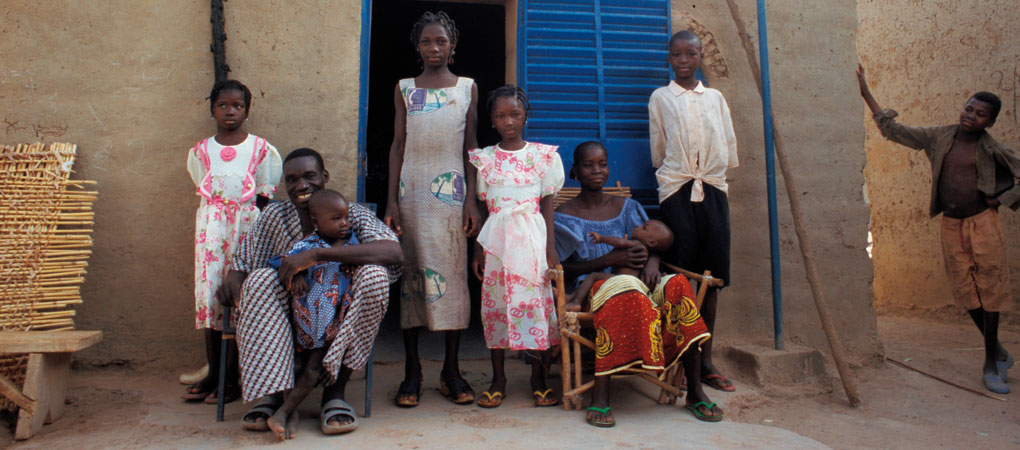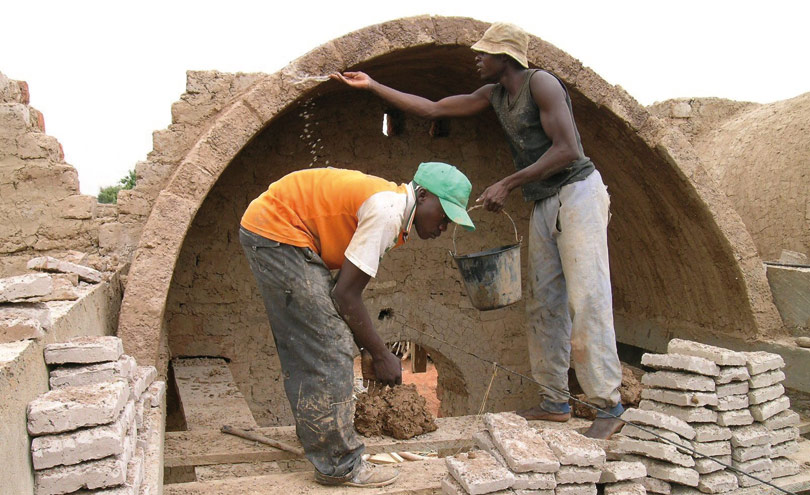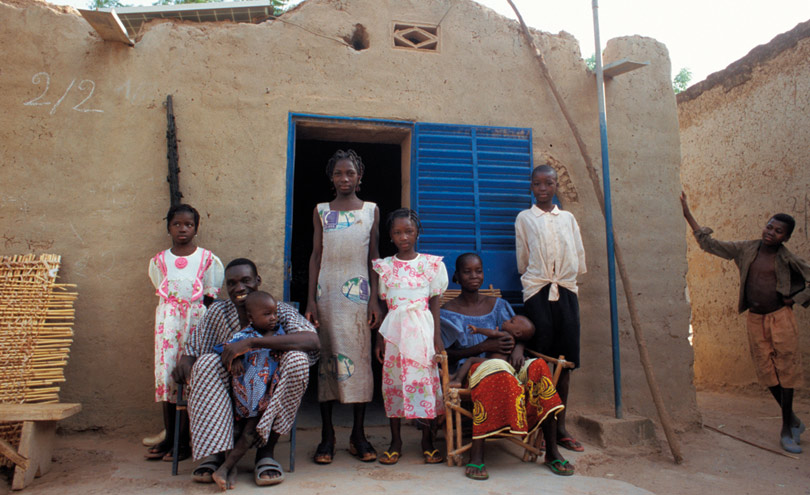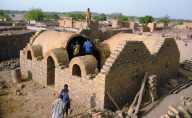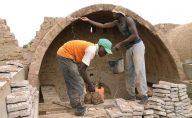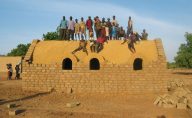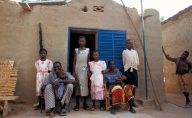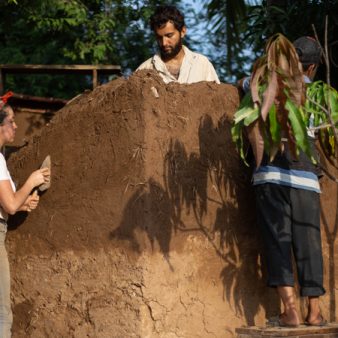Project Description
Aims and Objectives
The Earth Roofs for the Sahel programme aims to promote the construction of vaulted earth brick houses using the Nubian vault technique, or la Voute Nubienne (VN), and to develop a fast-growing and self-sustaining market in VN housing focussed on the rural poor of the Sahel through training, communication, support, and development work.
Programme context
With an estimated population of 150 million, the Sahel region of sub-Saharan Africa extends from the Atlantic in the west to the Red Sea in the east, covering an area of 3,053,200 km2. It is a transitional region of semi-arid grasslands, savannah, and thorn shrub-lands. Countries wholly or partly in the Sahel include Senegal, Mauritania, Guinea, Mali, Burkina Faso, Niger, Ivory Coast, Ghana, Togo, Nigeria, Chad, Sudan, and Eritrea. Nearly half the population is surviving at a bare subsistence level and housing conditions for the majority of the rural and peri-urban population are poor.
Approximately 30 per cent of the housing in the region is built using traditional methods incorporating dried earth brick walls, wood supports and a thatched, or earth and timber, roof. However, population growth in recent times, together with increasing desertification and the retreat of forested areas, means that the use of bush timber for construction is either illegal or requires expensive permits. As a result, families have had to resort to buying sheet metal, timber beams and rafters for roof-building. Sheet metal roofs have many serious disadvantages including poor thermal and sound insulation, a limited lifespan due to corrosion and as they are imported they must be paid for in cash, often a problem for those living outside any formal economic system. Finding the necessary funds for these materials becomes a major drain on family resources; yet around two-thirds of Sahelian families are living in houses with sheet metal roofs.
Key features
Initiated by the Association la Voute Nubienne (AVN) in 2000, the programme combines promotion of the VN technique in the Sahel with the training and development of masons who themselves become part of an increasing market for VN houses. The VN technique, a simplified, standardised adaptation of an ancient building technique from the Nubian region of Egypt, is relatively unknown in the Sahel and West Africa. Earth bricks are used in the construction and the vaulted roof is built without timber supports, used a sliding guide cord on a wire stretched between the gable walls to define the radius. The roof is waterproofed using locally produced plastic sheeting over a smooth coat of mud. This in turn is covered with a protective waterproofed earth rendering of two to three cm thickness. Doors and window openings are built around a temporary support using a standard oil drum.
This simplified technique was validated technically and financially during the first few years of AVN’s activity and is now in a phase of development and scaling up. AVN is a non-governmental organisation (NGO) registered in France (AVN International) and Burkina Faso (AVN-BF). AVN International is responsible for the overall management and development of AVN whilst AVN-BF organises the recruitment and on-the-job training of VN masons in the Sahel. It helps them to become independent VN entrepreneurs, and provides a developing pool of clients for them through its promotional, communication, and networking activities. To date, approximately 235 houses and 20 public buildings (including schools, dispensaries, churches and mosques) have been built. Over 115 masons have been trained and there are currently 170 apprentices.
A house built using the VN technique is more comfortable, healthy and robust than one with a sheet metal roof; it can be built with readily available local materials and labour, keeping scarce monetary resources in the local economy. The standard two-vault house (living room, two bedrooms, shower, and kitchen) has around 50 m2 of interior floor space; the usable area can be increased by transforming the roof into a flat terrace and additional vaults can be added on the roof to make a two-storey house as resources become available and families grow. The total average cost of a typical two-vault house (not including land) for labour, building materials and basic finishes is the equivalent of around US$1,500. However, as many of the VN client families are surviving essentially outside the cash economy, with very limited liquid cash resources, much of the cost of the house is met through bartering of crops and/or labour.
The programme is implemented in local communities in Burkina Faso, Mali and Senegal within geographic zones during each annual promotion campaign. In each zone, there is an initial visit to explore available labour and potential demand. As the building season begins (it runs from November until May) external VN building teams comprising one foreman, one mason and one apprentice arrive and begin work with one or more local apprentices. There is a phased progression for local masons from VN apprentices to VN masons and then onto master masons/trainers and eventually to entrepreneurs.
Covering costs
Actual construction and material costs are increasingly met by the households themselves with AVN restricting its financial input to a proportion of labour costs and training for the first buildings in new zones, and for provision of plastic sheeting for roof waterproofing. For example, the number of paid months of employment in VN construction has grown year on year (as the number of houses constructed each year has increased), from 30 salaried months of labour in 2000 up to 1,200 in 2008. Of these, the proportion of wages paid by AVN has sharply decreased from around 70 per cent in 2000 to only one per cent in 2008, indicating the growth of an active, self-sustaining market for VN houses.
The main project costs relate to organisation and scaling-up of the project, for example promotional activities, negotiations with potential clients and sponsors, recruitment and training of masons and monitoring of construction projects, rather than capital costs of construction. For example, the US$155,000 budget for the 2007/08 Programme was spent on technical support (75 per cent); administration, coordination and travel (18 per cent); communications and publicity (two per cent), and support for construction sites (five per cent).
AVN’s income derives from four sources: grants from private sector foundations (40 per cent); subsidies from the Ministry of Foreign Affairs and other public bodies in France (25 per cent); donations from individuals (14 per cent), and voluntary contributions towards construction costs for public use buildings financed by European NGOs (21 per cent).
Impact
- The houses are safer, as they will not collapse, and offer better security from intruders.
- Thermal and climatic comfort is significantly improved during extremes of heat, cold and rain.
- The construction method offers potential for future flexibility – for example, adding a flat terrace roof or extending by adding vaults to the side or on the roof.
- The programme has grown exponentially year on year. By 2008, 550 vaults had been built, 470 for rural family homes and 80 for public buildings. On average each home has two vaults, so the number of houses built is approximately 235.
- Over 115 VN masons have been trained and 170 apprentices are in training. The project has created income generation opportunities in an area where few exist.
- Three thousand salaried months of labour have been generated and there have been over 7,000 beneficiaries to date in Burkina Faso, Mali, Togo, and Senegal. This figure includes the VN masons, apprentices, labourers, families living in VN houses and users of the public buildings.
- The ratio of the number of apprentices trained each year to the number of masons is increasing (currently, it is 0.6). Interest in becoming an apprentice mason is very high, and as more are trained there are more available to carry out the training.
The increase in demand for construction of VN buildings over the last few years from people who have seen or visited an existing VN home, and want one of their own. Many VN masons have built their own VN homes. The demand is such that the Programme currently does not have enough masons trained in vault construction to satisfy it.
Why is it innovative?
The VN programme is not the first to have tried to re-establish the use of vaults for domestic architecture in rural areas such as the Sahel. However, the factors that differentiate this programme from other initiatives include:
- The simplicity of the technique, and the creation of transferrable standards and methodology.
- The training of masons is carried out in the community, on-the-job, on actual VN sites (and not in formal training centres removed from the local community). In this way, local, generally illiterate, masons familiar with earth brick construction can learn how to construct vaults fairly rapidly, in two to six months of apprenticeship, depending on their prior experience.
- The use of the VN technique is completely integrated into local economic circuits, with very little need for external financial resources, as most of the cost of construction is labour-related.
- Technical innovations include the possibility to easily convert the completed vaulted roof to a traditional flat terrace roof.
The VN technique can be adapted to suit the needs and financial resources of a wide range of clients. The vaulted roof can be converted to a flat terrace roof and the technique allows for later extension of a building, even adding a second storey onto an existing single storey building.
What is the environmental impact?
The project has led to a significant reduction in the use of imported materials as it relies solely on readily available local materials, principally earth and water. The bricks are made using human labour and are baked hard in the sun. The construction process uses manual labour and it has been estimated that, in the first six years of the programme, emissions of around 70 tonnes of CO2 have been saved. There has been a reduction in deforestation since a traditional house uses approximately 3m3 of timber, i.e. a saving of some 600m3 of precious timber through the construction of the existing VN buildings.
Is it financially sustainable?
Since 2000 there has been a 70 per cent annual increase year-on-year in the number of vaults built and VN masons trained. If this rate of progression can be maintained then AVN expects that within 10 years, a real self-sustaining, autonomous, market will have developed, reaching approximately five per cent of the population of the Sahel.
Ninety per cent of the cost of a VN house is for labour (the VN masons, apprentices, unskilled labourers, brick-makers), as the raw materials for construction (earth, water) are generally freely available. Poorer families who may not have the cash to pay a VN mason can often ‘pay’ through barter or labour exchange outside the formal money economy. Families who can’t afford to buy ready-made bricks from the local brick-maker can make them themselves during those periods of the year when work in the fields is minimal, and time is readily available. Aside from the purchase and provision of plastic sheeting for the roofs, nearly all the economic exchanges involved in the construction of a basic VN house can take place in the local economy, preserving any scarce cash resources for other items (food, fertiliser, school fees). This is in strong contrast to the very large amounts of cash (two thirds of the cost of the house) that have to leave the local economy for the purchase of imported sheet metal roofing panels, sawn timber beams, and concrete blocks used for construction of a ‘modern’ house.
What is the social impact?
The programme works with rural communities in the Sahel, who are among the poorest in the world and provides trainee masons with an income as well as giving them the tools to become entrepreneurs and run their own business. Most clients who are living in VN homes also come from the poorest segment of the population; they benefit from low cost and comfortable VN private homes. Money saved by constructing a VN home, as opposed to a metal-roof one, can be used to pay for education and health care.
Barriers
- The major barrier to the scaling up of the programme lies in the limits to the numbers of VN masons who can be trained each year. Demand to become an apprentice is high and AVN is working hard to accelerate the training of apprentices and increase the provision of support to existing VN masons to help them develop their entrepreneurial skills and client base.
- Technically, the main barrier is the seasonal lack of sufficient water for making the earth bricks; this can be overcome in many cases by ensuring that bricks are made and stocked well in advance, at the end of the rainy season.
Barriers to uptake amongst the programme’s key target population of poorer rural families include:
- Reservations about a technique new to this part of Africa and in particular the structural soundness and durability of timberless vaults. Such reservations are typically overcome once people have seen and visited a VN building.
- Concerns over maintenance of VN houses, even though the knowledge and skills to do this are traditional in the region (rendering and re-rendering work can be carried out by all members of the family).
- Perception that a VN house is beyond the rural population’s means and only for wealthier families. The fact that AVN has radically simplified the original Nubian vault technique, and that VN masons are drawn from local communities and trained on-the-job on actual construction sites, is going a long way towards breaking down this barrier.
Lessons Learned
- Stay as simple as possible: in the construction techniques, apprenticeship programmes, and relationships between the different actors in the Programme (AVN-International, AVN-Burkina Faso, the VN masons, and other NGOs).
- Stay as close as possible to the rural communities involved in the Programme, and build the growth of the Programme on solid foundations in the informal sector, reducing dependency on the cash economy as far as is feasible
- AVN must not get involved directly as a building contractor. The role of AVN-International, and of national centres such as AVN-Burkina Faso and AVN-Mali, is to put potential clients in touch with experienced VN masons.
- Provide an environment in which dependence on AVN by VN masons and local and national centres can be reduced.
- Target and limit the contributions of expatriates in specific areas of expertise as and when required. Examples include advice to the AVN-BF team on IT and record-keeping, advice to VN masons on costing and construction methods.
Evaluation
AVN-BF maintains records of VN masons in the country and their constructions, and also plays a role in quality control and checking of progress on sites. AVN’s partner NGOs carry out their own independent evaluations of their projects. The data from these various sources is regularly reviewed by the AVN Management Committee as part of the continuing development of the project as a whole. Ongoing and periodic monitoring in the field is complemented by external technical evaluations carried out by independent evaluators every two years and all reports, evaluations and technical papers are made available on the AVN website.
All the VN masons in Burkina Faso and Mali are invited to twice yearly congresses, with three-day meetings held at the start (Oct/Nov) and end (June) of each building season, to discuss and coordinate plans and to review and monitor the projects undertaken.
Transfer
Scaling up of the programme occurs when the approach is taken into new areas, leading to the training of new masons who develop their own clients. Larger building projects funded by NGOs and other organisations (for example schools and community health centres) play an important role in accelerating the recruitment and training of new VN masons. AVN uses the Action Zone Model to scale up its work, based on the area a master-mason can cover with his moped in a day. AVN is also testing other options for scaling up, including long-term partnerships with NGOs and other organisations, a pilot village strategy, a franchise model and setting up VN masons’ cooperatives.
The pilot village involves identifying a local champion and a group of villagers with whom a four-year programme of construction and training is agreed. AVN provide the initial expertise in the form of VN mason-trainers. An example is in the region of Koutiala, southern Mali, where the local champion is the Imam of a village mosque. One year on, 10 local apprentices have learnt how to construct VN vaults, three houses have been built in neighbouring villages, and a further 18 houses, two mosques, and a school are planned for the second year of construction (2009/10) in the original three villages, and seven others in the area.
The Programme has seen a fairly rapid expansion in Burkina Faso. Originally centred on one zone around Boromo, a further seven zones have been opened. Some Burkinabé VN masons are working outside these action zones (including one in Togo, and one in Ivory Coast), entirely on their own initiative, but in the knowledge that they can contact the team in Boromo if they need advice. A new coordination centre was set up in Bamako in early 2009, to provide support to the rapidly increasing number of VN projects in Mali. A further cluster of Senegalese VN masons, originally trained by masons from Burkina Faso, are now working on projects in the Matam region of Senegal.

